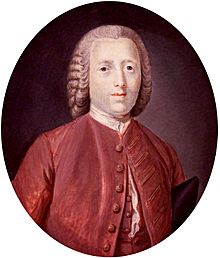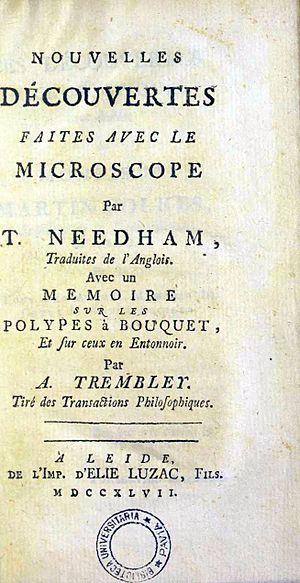John Needham facts for kids
Quick facts for kids
John Needham
|
|
|---|---|

John Needham
|
|
| Born | 10 September 1713 |
| Died | 30 December 1781 (aged 68) |
| Nationality | English |
| Scientific career | |
| Fields | Biology |
John Turberville Needham (born September 10, 1713 – died December 30, 1781) was an English scientist and a Roman Catholic priest. He was very interested in how living things came to be. He is best known for his experiments on something called spontaneous generation. This was an old idea that living things could appear from non-living matter.
Contents
John Needham's Life and Work
John Needham was born in England in 1713. He became a priest but also loved studying nature. This field was called natural philosophy back then. It included science, especially biology and geology.
He wrote a paper about geology. In this paper, he also explained how pollen works. This work helped him become known in the world of botany, which is the study of plants.
His Experiments with Life
Needham was very curious about spontaneous generation. This idea suggested that tiny living things, like microbes, could just appear from non-living stuff. For example, people thought maggots could come from rotting meat.
To test this, Needham did some experiments.
- He would boil a broth mixture, like gravy, for a short time.
- Then, he would let it cool down in an open container.
- After it cooled, he would seal the container.
- A few days later, he would find tiny living things (microbes) growing in the sealed broth.
Needham thought these experiments proved that a "life force" was creating new life. He believed this supported the idea of spontaneous generation.
Why His Experiments Were Challenged
Today, we know why Needham's experiments showed microbes growing.
- He did not boil the broth long enough. This meant some tough microbe parts, called endospores, could survive the heat.
- He cooled the broth in an open container. This allowed new microbes from the air to fall into the broth and contaminate it.
- He did not use proper sterile technique. This means he did not make sure everything was completely clean and free of germs.
Another scientist, Lazzaro Spallanzani from Italy, later challenged Needham's findings. Spallanzani repeated the experiments but changed a few things. He boiled his broth for a much longer time. He also sealed his flasks while they were still hot. Spallanzani found that no microbes grew in his sealed flasks. This showed that Needham's results were likely due to contamination, not spontaneous generation.
Other Facts About Needham
Some people, like the writer Voltaire, mistakenly thought John Needham was an Irish Jesuit. This was part of a disagreement they had about spontaneous generation. However, Needham was actually an English priest.
In 1747, John Needham became a member of the Royal Society. This was a very important scientific group in England. He was the first Catholic priest to join this famous society.
Needham's experiments were even mentioned by a French philosopher named Baron d'Holbach. He used Needham's ideas in his book, System of Nature.
Works
John Needham wrote several books about his scientific discoveries. Here are some of them:
- An Account of Some New Microscopical Discoveries. This book was published in 1745.
- New microscopical discoveries. This was also published in 1745.
- Observations upon the Generation, Composition, and Decomposition of Animal and Vegetable Substances. He published this book in 1749.


